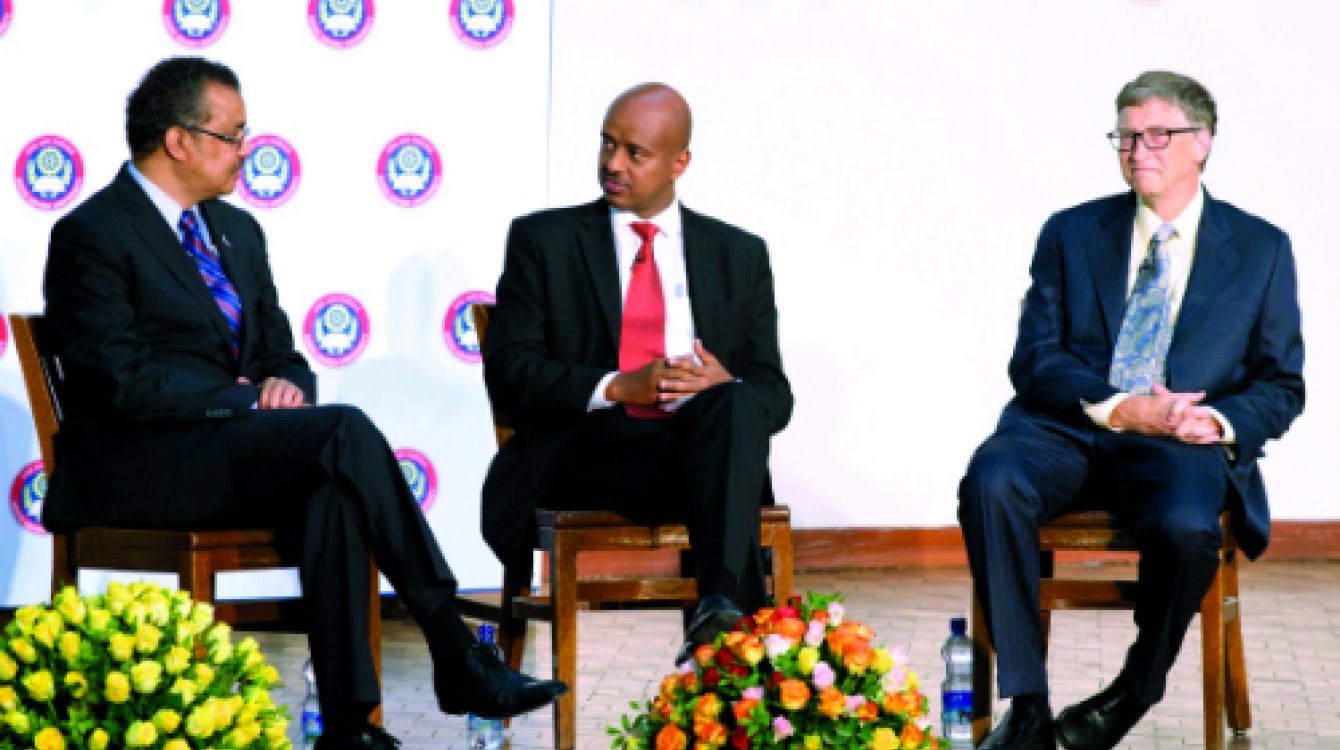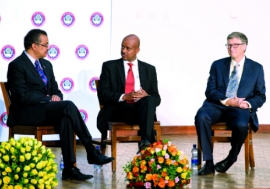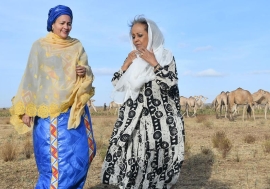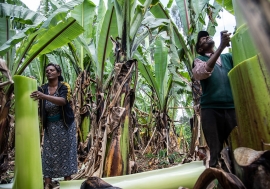Ethiopia’s development is mostly people-driven
Why did the Gates Foundation choose Ethiopia to host its first office in Africa?
It’s for a few reasons, but primarily there are two reasons why we have a large concentration of our work here. First, the need is significant. There is a huge population with a heavy poverty and disease burden. Second, we believe in the promise of Ethiopia. We think the government’s commitment and investments to pro-poor sectors, with support from development partners, has enabled our investments to yield positive results. We place high value on partnerships, and since we understand the government’s agenda, we are able to contribute in a way more aligned to their priorities. There are also some logistical reasons why Ethiopia makes sense. It’s the diplomatic capital of Africa: you can reach the rest of Africa because the African Union and the United Nations Economic Commission for Africa are based here.
How did Ethiopia got to be among the top 10 fastest growing economies in the world?
The government has been clear about how it wants to grow the economy. It is committed both to growth and to lifting many people out of poverty. This is actually a compelling story. If you look at the government budget, about 65 to 70% of it goes to pro-poor development activities such as agriculture, health, education and infrastructure. They’ve also been very focused on infrastructure: the road and the light rail network is impressive. The power generation work Ethiopia has embarked upon is impressive. In a very short period of time, it is going to be a power hub, generating sufficient power not just for itself but also for export to other countries. Telecom is another example of infrastructure the government has planned quite well. But going forward, I’m not sure all these will be sufficient. Massive and expanded activities from the private sector will need to be coupled with the public sector for continued growth. So far, growth has been heavily dependent on public sector investment.
Are there any specific policies targeted at encouraging private sector investments?
The government is going above and beyond to strengthen the capacity of the private sector and also to attract FDI [foreign direct investment] to support development. They are doing that by providing different incentives. There’s a promotional effort to attract investments, depending on the sectors they think are catalytic to growth. The government is planning to invest heavily on industrial zones across the country that will house textile, leather, agro-processing and other labor-intensive factories. The hospitality industry is also another one they are eager to attract investments.
Many countries are concerned about high growth rates alongside growing unemployment. How is Ethiopia dealing with jobless growth?
I’m not exactly sure how many jobs have been created as a result of the growth in Ethiopia, but there are a couple of things the government is trying to do. First, there is a huge emphasis on building and maintaining small enterprises to feed into the industry. For example, there is a large public housing scheme where many of the products and labour are supplied by small and micro-enterprises. The goal is to grow them into medium and large size companies. Second, there is a shift of focus to manufacturing. The government has an interest in creating a large employment base. They now have shoe, leather and textile companies that are setting up shop for European and US markets. The likes of H&M, Zara, Tommy Hilfiger and Calvin Klein brands and other big name shoe companies are now outsourcing to Ethiopia. And then there is the service industry that’s growing at a high rate and creating employment opportunities as well. The growth that has happened may not have created many jobs, there will be a the current policy and efforts are geared towards a huge addition to the employment base.
Another positive story in Ethiopia is agriculture. What has made Ethiopia move from famine 30 years ago to the current success in agriculture?
Here again, there are multiple reasons why agriculture has performed well. The sector’s impact on Ethiopia is pretty significant: 45% of the GDP comes from agriculture; 80-85% of employment comes from agriculture and it is also a huge source of the export commodities. Ethiopia has a history of food insecurity, given the weather and management challenges the country has had. There has been a concentrated effort by all the players, governments, donors, farmers and others to change that. If you change the story of agriculture, you change the story of Ethiopia, given how the two are intertwined.
Productivity has increased significantly, the market structure, while not perfect, has improved and technology is impacting the agriculture sector as well. Compared to 20 years ago, the country now has better seeds, better management techniques, more fertilizer and access to domestic and international markets. In some pockets of the country, farmers have done phenomenally well. There’s a programme where these high performing farmers can be examples to their community.
Several years ago, Ethiopia created an institution, the Agricultural Transformation Agency, which the UN, through UNDP, has been supporting. It’s a government agency and staffed by highly trained technical people able to drive the transformation agenda. Ethiopia has consistently allocated 10-17% of its budget on agriculture. The other interesting thing that has happened is the resilience built around food insecurity. Because the network of food distribution and early warning systems built, even when there is drought, the number of people impacted is minimal.
Where is Ethiopia getting the money to finance all these projects, like the Grand Renaissance Dam?
A portion of the money on infrastructure is coming from the government. But that’s not sufficient for the massive infrastructure that they have undertaken. I would separate the dam from the rest of the other projects because that one is a special project that’s being financed partly by government but mostly by the people of Ethiopia themselves. There are a number of mechanisms that the people are using to contribute to this iconic dam, at least in the context of Ethiopia. People from all walks of life are contributing to the dam through the purchase of bonds. The other projects are financed by the government and external resources, mostly concessional loans.
Are there lessons for other countries from this type of financing scheme?
Absolutely, I don’t see any reason why, if there’s a project of significance and national pride, the government and people of any country can’t say, ‘This is us, this is ours, and we’re going to do this ourselves.’ Hopefully the completion of the Grand Renaissance Dam will be a shining example of that. For the other projects, in addition to the government’s own commitment and putting resources makes it obviously clear that China has been a very strong partner in developing this infrastructure – namely rail, roads, telecom and power generation projects. A lot of the money has come from China as soft loans. So on infrastructure, I wouldn’t underestimate the role China has played in providing the finance and technical expertise.
Some economic experts are fascinated by the economic model that Ethiopia is following. What can other African countries learn from this model?
The lesson for other countries is not so much following Ethiopia’s economic model, because it is tailored for Ethiopia’s current needs and aspirations. I wouldn’t try to say it should be emulated. But what is worth picking up here is the strong role that the state plays in charting the course of the economic model it needs, in consultations with its experts. Generally speaking, I would say Ethiopia’s economic model has worked for Ethiopia. It’s worth looking at the process by which they identified their economic model, and followed through to make it happen. But each country should look at the economic model that best suits its dynamics.
Still, some experts have looked at what Ethiopia is doing and draw similarities with China’s economic model. Do you think there are some parallels?
My sense – and this is my own observation – is that the Chinese economic model of success resonates with the current Ethiopian economic situation, given that China has gone through this growth in recent history. The model under which they had high economic growth given the base where they started is very relevant to Ethiopia because it is where China was 25 years ago. My hope is that we don’t just do what China or other countries did; you pick and choose what makes sense for you.
China wouldn’t be investing here on a large scale if they didn’t agree with Ethiopia’s economic model, if they didn’t see a return on their investments.
I am sure the Chinese have made their calculations about placing this kind of money in Ethiopia. It’s not a gift, it’s with the assumption that the growth model is solid enough that once the country grows and generates revenue, the money will be paid back with interest. The primary drivers of the economic models are the Ethiopians themselves and they have to decide what works best for them. So far, the country’s credit rating is a solid B with fiscal deficit target of 2.9 percent of GDP this year.
Whenever people talk about Ethiopia’s economic success, they also make reference to human rights issues. Do you think there is a sacrifice between economic development and human rights?
I would look at them separately. I tend to agree with former Prime Minister Meles Zenawi who said: ‘Democracy and human rights are not necessary prerequisites for economic growth. Ethiopia can grow without having those things attached to economic progress.’ But for a country like Ethiopia that has a multi-ethnic, multi-religious population to survive over a period of time, those basic human rights, democracy, freedom of speech, and other things have to be embedded into society. Without that, your survival cannot be ensured. It is an interesting view. You can grow without adequately providing these things, but the entire system and your entire survival over time could be questioned because you have to have a democratic society that aspires for a brighter future. Ethiopia’s diversity is incredible at all levels. In talking to policy makers, I don’t think there is a sense of sacrifice per se; but they think it is an evolutionary process. Democracy is a process, you don’t perfect it, and even the most developed countries have not perfected it. Ethiopia is a very young democracy. It is a 20-year old democracy, so if you’re making progress in the right direction and doing your level best to reach a very good and comfortable level of pace, it’s good. Now, one can argue the pace in the last 20 years could have been faster. And others would say this is actually good in just a 20-year period. I’m not an expert, so I think to me the conversation should be how fast those things are improving. If the pace is not fast enough, maybe that needs to be accelerated. But otherwise, I’m not sure how in a 20-year period, you can have a flourishing democracy. I don’t know any other country that has done that in 20 years. I spent most of my time in the US and it took Americans a long time to be able to establish that, and I think we have to create that space for African and developing countries to be able to do that. But if that rate of progress is slow, I think everyone should push that to be accelerated.
Ethiopia is surrounded by unstable neighbours. How does it manage to remain stable and develop in such a rough neighbourhood?
You’re absolutely right about how difficult of a neighbourhood Ethiopia is in. I think again Ethiopia deserves a lot of credit for its strength – it has very strong military capabilities that have served it well – but also for their diplomacy is strong. Perhaps with the exception of Eritrea, Ethiopia has managed to have a very good and respectful relationship with the other countries. Even in the case of Sudan and South Sudan conflicts, Ethiopia has been the lead mediator trusted by all parties in this conflict. Ethiopia is also supporting peace efforts in Somalia. Ethiopia has done well in building its own military capability to protect itself but also playing a role in mediating these conflicts and finding lasting solutions to the challenges that the region faces. So I think that has to be one of the successes of Ethiopia. The other interesting story around this is its willingness to help other people. Back in the 1980s and early 1990s, Ethiopia was probably the top country of origin for refugees. Ethiopians were leaving their troubled country …Today Ethiopia is the largest refugee-hosting country in Africa, close to 700,000 refugees are settled here.
























